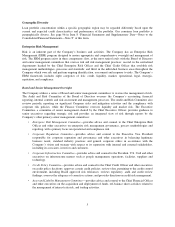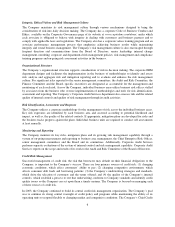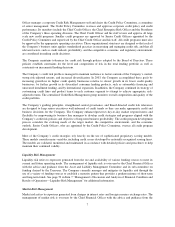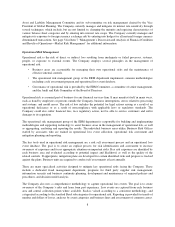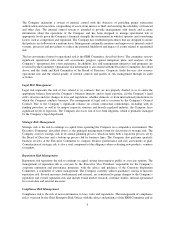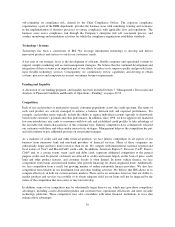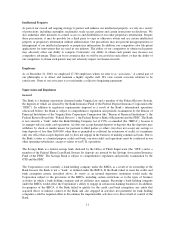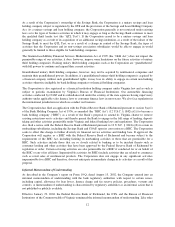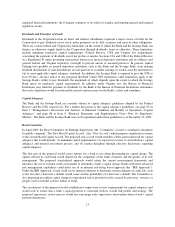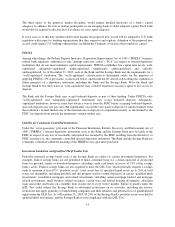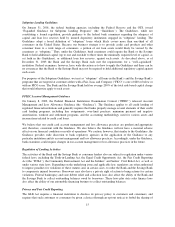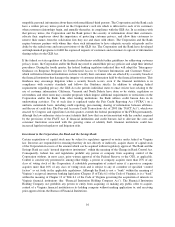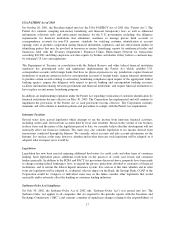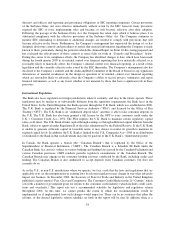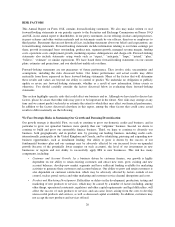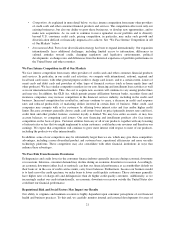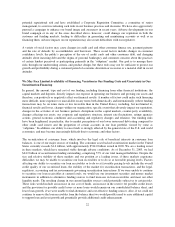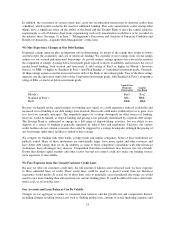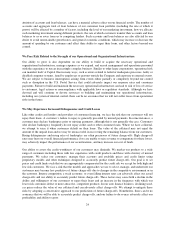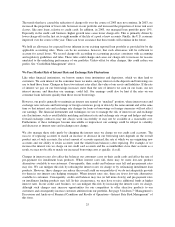Capital One 2003 Annual Report Download - page 33
Download and view the complete annual report
Please find page 33 of the 2003 Capital One annual report below. You can navigate through the pages in the report by either clicking on the pages listed below, or by using the keyword search tool below to find specific information within the annual report.Subprime Lending Guidelines
On January 31, 2001, the federal banking agencies, including the Federal Reserve and the OTS, issued
“Expanded Guidance for Subprime Lending Programs” (the “Guidelines”). The Guidelines, while not
constituting a formal regulation, provide guidance to the federal bank examiners regarding the adequacy of
capital and loan loss reserves held by insured depository institutions engaged in “subprime” lending. The
Guidelines adopt a broad definition of “subprime” loans which likely covers more than one-third of all
consumers in the United States. Because our business strategy is to provide credit card products and other
consumer loans to a wide range of consumers, a portion of our loan assets would likely be viewed by the
examiners as “subprime.” Thus, under the Guidelines, bank examiners could require the Bank or the Savings
Bank to hold additional capital (up to one and one-half to three times the minimally required level of capital, as
set forth in the Guidelines), or additional loan loss reserves, against such assets. As described above, as of
December 31, 2003 the Bank and the Savings Bank each met the requirements for a “well-capitalized”
institution. Federal examiners, however, have wide discretion as to how to apply the Guidelines and there can be
no assurances that the Bank or the Savings Bank may not be required to hold additional regulatory capital against
such assets.
For purposes of the Subprime Guidelines, we treat as “subprime” all loans in the Bank’s and the Savings Bank’s
programs that are targeted at customers either with a Fair, Isaac and Company (“FICO”) score of 660 or below or
with no FICO score. The Bank and the Savings Bank hold on average 200% of the total risk-based capital charge
that would otherwise apply to such assets.
FFIEC Account Management Guidance
On January 8, 2003, the Federal Financial Institutions Examination Council (“FFIEC”) released Account
Management and Loss Allowance Guidance (the “Guidance”). The Guidance applies to all credit lending of
regulated financial institutions and generally requires that banks properly manage several elements of their credit
card lending programs, including line assignments, over-limit practices, minimum payment and negative
amortization, workout and settlement programs, and the accounting methodology used for various assets and
income items related to credit card loans.
We believe that our credit card account management and loss allowance practices are prudent and appropriate
and, therefore, consistent with the Guidance. We also believe the Guidance will not have a material adverse
effect on our financial condition or results of operations. We caution, however, that similar to the Guidelines, the
Guidance provides wide discretion to bank regulatory agencies in the application of the Guidance to any
particular institution and its account management and loss allowance practices. Accordingly, under the Guidance,
bank examiners could require changes in our account management or loss allowance practices in the future.
Regulation of Lending Activities
The activities of the Bank and the Savings Bank as consumer lenders also are subject to regulation under various
federal laws, including the Truth-in-Lending Act, the Equal Credit Opportunity Act, the Fair Credit Reporting
Act (the “FCRA”), the Community Reinvestment Act and the Soldiers’ and Sailors’ Civil Relief Act, as well as
under various state laws. Depending on the underlying issue and applicable law, regulators are often authorized
to impose penalties for violations of these statutes and, in certain cases, to order the Bank and the Savings Bank
to compensate injured borrowers. Borrowers may also have a private right of action to bring actions for certain
violations. Federal bankruptcy and state debtor relief and collection laws also affect the ability of the Bank and
the Savings Bank to collect outstanding balances owed by borrowers. These laws plus state sales finance laws
also affect the ability of our automobile financing business to collect outstanding balances.
Privacy and Fair Credit Reporting
The GLB Act requires a financial institution to disclose its privacy policy to customers and consumers, and
requires that such customers or consumers be given a choice (through an opt-out notice) to forbid the sharing of
15


